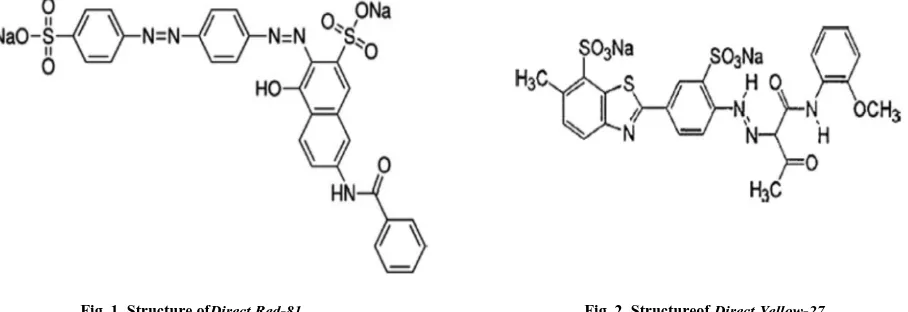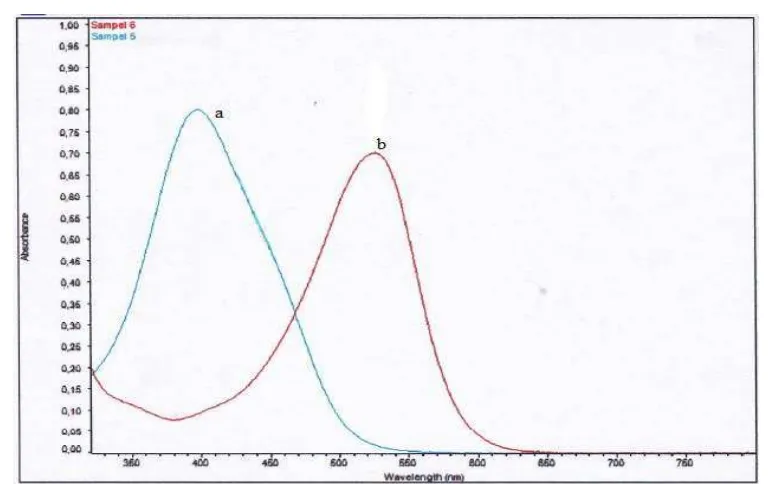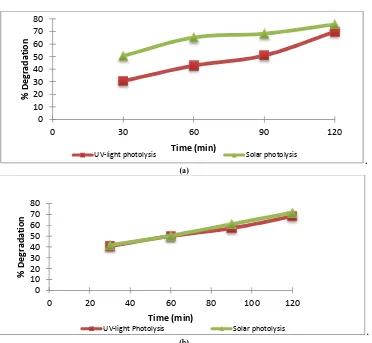ISSN 0975-413X
CODEN (USA): PCHHAX
(http://derpharmachemica.com/archive.html)Der Pharma Chemica, 2016, 8(12):30-35Degradation of direct red-81 and direct yellow-27 by photolysis with UV-light
and solar irradiation using C-N-codoped TiO
2Safni Safni
1*, Deliza
1, Deby Anggraini
1, Rahmi Sari Dewi
1, Hasnah Ulia
1and Diana Vanda Wellia
21Laboratory of Applied Analytical-Chemistry, Department of Chemistry, Faculty of Mathematics and Natural
Sciences, Andalas University, Indonesia
2Laboratory of Material Chemistry, Department of Chemistry, Faculty of Mathematics and Natural Sciences,
Andalas University, Indonesia
_____________________________________________________________________________________________
ABSTRACT
Direct Red-81 (C28H19N5Na2O8S2) and Direct Yellow-27 (C28H19N5Na2O6S4) are non-biodegradable organic
compound containing azo group and confirmed carcinogenic. Direct Red-81 and Direct Yellow-27 were degraded by photolysis method under 10 watt UV-light irradiation (λ=365 nm) and solar irradiationwith and without C-N-codoped TiO2 catalyst. The dyes solution was analyzed\by UV-Vis spectrophotometer at λ 300-800nm. The optimum
mass of C-N-codoped TiO2catalyst was 10 mg. From those methods, concluding solar irradiation method enhanced
better degradation than UV-light irradiation, Direct Red-81 and Direct Yellow-27 were degraded 17.37 % and 8.72 % by solar irradiation and the degradation percentage increased to 75.63 % and 71.52 % by the addition ofC-N-codoped TiO2catalyst for 120 minutes.
Keywords: Dye, Direct Red-81, Direct Yellow-27, Degradation, Photolysis, Catalyst, C-N-codoped TiO2, Solar
Irradiation
_____________________________________________________________________________________________
INTRODUCTION
Wastewater of industrial textile mostly contains Direct Red-81 and Direct Yellow-27 which are non-biodegradable compounds. It contains azo group andits carcinogenicity can cause kidney damage, cancer, and heart disease.Dyes in aquatic and human life can decrease sun-light exposure, while photosyntesis process and air solvation process will be decrease as effect. Evaluation is necessary to know pollution level which have been reached and wastewater treatment effectively, so negative effect of pollution can be prevent and anticipation before pollution goes worse. Hence, it needs effective treatmentsto prevent dyes go to the streams which people use for life activity. Without treatments, it potentially be the reason of water pollution, means significantly decline the quality of water which is consumed by living-thing[1-4].
Treatments of dyes have been done by different techniques such as biodegradation, adsorption, coagulation, reverse osmosis, etc. Those techniques with non-desctructive properties are not compatible to remove waste because treatments change waste into another phase with the same side efffect[5]. In case, biodegradation is not work properly because it has high resistance to dyes moleculs, so it can split into corresponding aromatic amines by damage[6-8].
In previous work, Direct Red-23, Direct Violet and Yellow GCN have been degraded over sonolysis, ozonolysis and photolysis processwithUV-light and solarirradiation. The degradation processes were done with addition of N-doped TiO2catalyst, while Yellow GCN has been degraded with addition of C-N-codoped TiO2 catalyst.8 mg/L of Direct
Red-23 and Direct Violet could be degraded by 39,378 % and 25,893 % after 120 minutes UV-Light irradiation by using 20 mg N-doped TiO2 catalyst, andYellow GCNthe degradation percentage increase to 23,6% by using 10 mg
C-N-codoped TiO2 catalyst.It degreded Direct Red-23 over 62,696 % , Direct Violet only 62,5 % after 120 minutes
solar irradiation by using 20 mg N-doped TiO2 catalyst. While, yellow-GCN could be degraded18,7% after 120
minutes solar irradiation and the degradation percentage increase to 38,0% by using 10 mg C-N-codoped TiO2
catalyst[8-10].
In this work, Direct Red-81 and Direct Yellow-27 are degraded by photolysis process with UV-light and solar irradiation using C-N-codoped TiO2 as catalyst.
MATERIALS AND METHODS
Equipments and materials
Equipments which were used are Spectrophotometer UV-Vis (S.1000 Secomam Sarcelles, French), UV-lamp (Germicidal CE G 13 Base BFC11004, λ=365 nm, 10 Watt), irradiation box, analytical balance, centrifugewith 10.000 rpm, petridish, and other glasses equipment’s.
Materials are Direct Red-81 (C28H19N5Na2O8S2, Mr = 675 g/Mol) as Fig. 1, Direct Yellow-27 (C28H19N5Na2O6S4, Mr
= 695 g/Mol) as Fig. 2 were get from Silungkang textile-industry, double distilled water, and C-N-codoped TiO2as
catalysts were made in laboratory.
Fig. 1. Structure ofDirect Red-81 Fig. 2. Structureof Direct Yellow-27
Degradation of Direct Red-81 and Direct Yellow-27by photolysis
Direct Red-81 solutions filled into petridish, degradationwas done by photolysis under UV-lamp (λ=365 nm, 10
Watt)andsolar irradiation within time variations. Absorbance of residue dyes-solution was measured by UV-Vis Spectrophotometer in its maximum wavelength to get percent of degradation. Same treatments were done to degradation of Direct Yellow-27 with addition of C-N-codoped TiO2.
Effect of C-N-codoped TiO2
Effect of C-N-codoped TiO2mass to degradation of Direct Red-81 and Direct Yellow-27was learned by added
variation mass (5-25 mg) of its into dyes solution which degradedby photolysis with UV lamp and solar irradiationwithin 2 hours. Absorbances of residue dyes-solution was measured by UV-Vis Spectrophotometer in its maximum wavelengthto get percent of degradation.
RESULTS AND DISCUSSION
Fig. 3.Spectrum of ( a)Direct Red-81and (b)Direct Yellow-27
Determination mass optimum of C-N-codoped TiO2in degradation process
Fig. 4 shows that variation mass (in range of 5 to 25 mg) of C-N-codoped TiO2catalyst affect to degradation
percentage of Direct Red-81. From this figure, we can see that the optimumC-N-codoped TiO2catalyst mass is 10
mg with 53.13% degradation of Direct Red-81. The photocatalysis plays important role in photodegradation process, due to producing the hydroxyl radical[11].
.
Fig. 4. Effect of C-N-codoped TiO2 catalyst-massto degradation of Direct Red-81
Effect of degradation time
Fig. 5.showsthat increasing time of photolysis with UV-light irradiation as well as solar irradiation is followed by increasing degradation of Direct Red-81 andDirect Yellow-27.Direct Red-81 is more active in the area of visible light because it has a maximum absorbance at 508 nm unlike the case of Direct Yellow-27 is more active inUV light (λ = 398 nm). Hence Direct Red-81 is easier degraded than Direct Yellow-27 because it has much π bond in and also contain a lot of small energy bonding groups in its molecular structure (asFig. 2).It was observed as long as irradiation occured, it was equal to degradation process, in solar irradiation there was •OH as agentthat declined toxic compounds in the solution by attacked mostly double chains, such as N=N, C=C and C=N, and •OH be produced by UV-light and solar irradiation.
0 10 20 30 40 50 60
0 5 10 15 20 25
%
d
eg
ra
d
a
ti
o
n
.
(a) (b)
Fig. 5. Effect of degradation time to degradation percentage of Direct Red-81 and Direct Yellow-27, without catalyst (a).Solar irradiation(b). UV-lightirradiation
Effect of C-N-codoped TiO2Catalyst inSolar Irradition and UV-LightIrradiation
.
(a) (b)
Fig.6.(a)Effect of C-N-codoped TiO2catalyst in Direct Red-81degradation by Solar irradiation, (b) UV-light irradiation
..
(a) (b)
than without the addition of catalyst. It was evaluated that catalyst accelerated rate of reaction without including in the reaction. Degradation process was started by photoexcitation because UV-light adsorbed to C-N-codoped TiO2surface, so electrons in C-N-codoped TiO2excited from valence band to conduction band and produced hole
(hvb+) in valance band then reacted with H2O in the air to form OH-(OH•). Next process was electrons in conduction
band (ecb-) reacted to oxygen producing superoxide ion (O2•-), then reacted with water forming OH•[12].
Effect of Light Source toDegradation Percentageof Direct Red-81 and Direct Yellow-27
. (a)
. (b)
Fig. 7Effect of light source to degradation percentage of (a) Direct Red-81 and(b) Direct Yellow-27 with addition of C-N-codoped TiO2catalyst
Fig. 7 (a) and (b) shows that thesolar irradiation reached higher percentage of degradation,such as 75.63 % for Direct Red-81 and 71.52 % for Direct Yellow-27within 120 minutes. Solar irradiation can be use to degradate organic compounds in liquid phase, also it can be detracted by hidroxil ion (OH-) or its conjugate base H2O2 (HO2-)
becomes HO2• radical and OH• which support degradation process. The degradation process can be optimize with
addition of C-N-codoped TiO2 catalystsby solar irradiation because C-N-codoped TiO2 particles excited then hole
(positif charge) in valance band (h+) on TiO2 surface formed increasingly as well as OH• that degraded Direct
Red-81 and Direct Yellow-27[12].
CONCLUSION
The degradation of Direct Red-81 and Direct Yellow-27 was obviously affected by the addition of catalyst and light source of irradiation. Solar irradiation method enhanced better degradation than UV-light irradiation. Direct Red-81 and Direct Yellow-27 were degraded 17.37 % and 8.72 % by UV-light irradiation and the degradation percentage increased to 75.63 % and 71.52 % by solar irradiation and with addition of C-N-codoped TiO2 catalyst for 120
minutes.
Acknowledgements
REFERENCES
[1] S. Zodi, B. Merzouk, O. Potier, F. Lapicque, J.P. Leclerc, Separation and Purification Technology, 2013, 108: 215–222.
[2] R.P.F. Melo, E.L. Barros Neto, M.C.P.A. Moura, T.N.C. Dantas, A.A.D. Neto, H.N.M. Oliveira, Journal of Water Process Engineering,2015,7: 196–202
[3] M. Punji, A. Anbalagan, R.A. Borner, B.M. Svensson, M. Jonstrup, and B. Mattiasson,Chemical Engineering Journal.,2015, 270: 290-299.
[4] A.D. Mani, S. Muthusamy, S. Anandan, C.H. Subrahmanyam, Journal of Experimental Nanoscience, 2013, 10: 115-125.
[5] Chen, C, Water, Air and Soil Pollution, 2009,202 (1–4): 335–342.
[6] Chen, Xiaobo, Burda, Clemens, J. Am. Chem. Soc., 2008,130 (15): 5018-5019. [7] H.M. Pinheiro, E. Touraud, O. Thomas,Dye and Pigments,2004, 61: 121–139.
[8] Safni, D.V. Wellia, P.S. Komala, R.A. Putri,Journal of Chemical and Pharmaceutical Research,2015,7 (11): 306-311.
[9] Safni, D. Anggraini, D.V. Wellia, Khoiriah.Jurnal Litbang Industri, 2016,5(2): 123-130. [10] Y. Liu, X. Chen, J. Li, C. Burda., 2005, 61 (1): 11-18
[11] B. Neppolian, S.R. Kanel, H.C. Choi, M.V. Shankar, B. Arabindoo, and V. Murugesan, International Journal of Photoenergy, 2003, 5: 45-49



